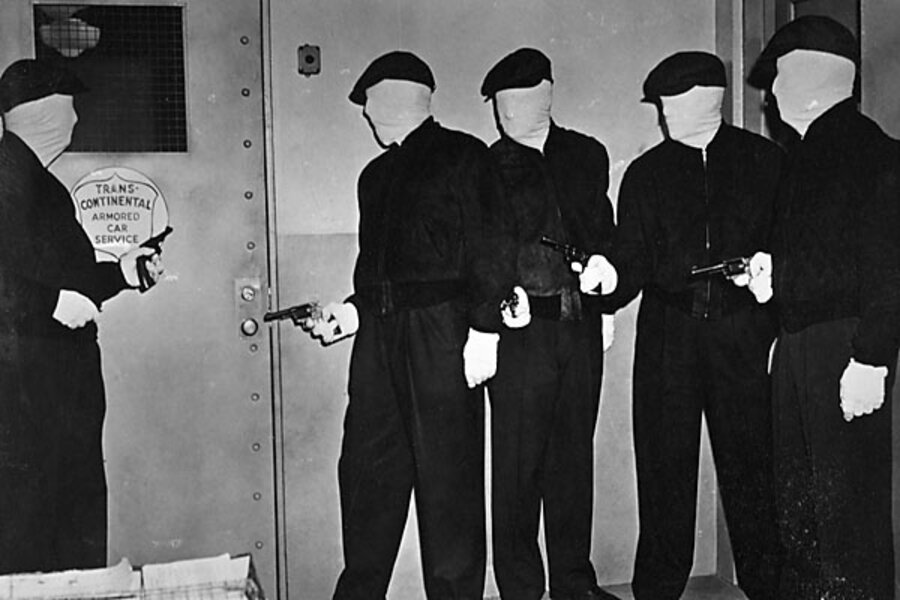Spend it like you stole it
Loading...
QE2 is ending in June. But globally, QE3 has already begun. As usual, Japan is the pacesetter. As temperatures rose at its Fukushima reactor so did Japan’s monetary base – at the rate of 100% per week! What happens to all this new, hot money? No one knows, exactly. But today, at The Daily Reckoning, we have advice for everyone – central planners, politicians, and householders, too: if you have money, pretend you robbed a bank.
From the point of view of a modern economist, nothing stimulates better than a bank robbery. The money leaves the cold embrace of a bank vault; soon every pimp and bartender has his pockets full. Hot money gets around.
An article in Rolling Stone Magazine provides an illustration. It explains how one Wall Street wife, and one Wall Street widow, formed a company specifically to take advantage of the US government’s spending spree known as TALF. You’d think the feds had already done enough for the Mack family. John Mack runs Morgan Stanley. Had it not been for the generous support of the US government and the Federal Reserve, he might be parking cars. Instead, the feds bailed out the entire financial sector. First, it bought up Wall Street’s bad bets at inflated prices and then lent banks money at artificially low interest rates; they were invited to lend the money back to the federal government for a sure profit.
Business was so good at Morgan Stanley that the distaff side of the Mack household apparently couldn’t resist. In June, 2009, with her friend Susan Christy, Mack set up an investment company and put in $15 million. Then, they borrowed $220 million from the government. A brave move on their part? If you think so, you are as naïve as a turnip. The fix was in; the two used the money to buy non-recourse loans at deep discount. If the loans increased in value, they would make a profit. If they fell, the government would take the losses. Much safer and more profitable than robbing banks. Two months later, Mr. Mack, perhaps with a little assistance from his blond helpmate, bought a limestone carriage house in Manhattan, with a 12-space garage for the getaway cars.
If you don’t have your own little stimulus scam going, you may want to listen up. Your dollars, pounds, euros and pesos are going to lose value. Don’t trust the government’s inflation figures. An honest measure of the “inflation rate” is available thanks to a pair of professors at MIT. Their “Billion Prices Project” (BPP) doesn’t pussyfoot around. It trolls the Internet, records prices and reveals the most accurate measure of inflation ever. This new index shows the rate of consumer price increases for the last 12 months at 3.2%. This is more than half again as much as the Labor Department’s own tally – 2.1%.
Something is dreadfully wrong. Either a billion prices are in error. Or, people who buy US treasury bonds are. They accept a real yield (based on the BPP numbers) of barely 1.2% on a 30-year dollar-denominated, inflation-sensitive Treasury bond, while the dollar sinks and its custodians actively try to drown it. And, over the last six months, according to BPP, prices have been rising nearly twice as fast – at a 6.1% annualized rate. If these figures hold, bond investors already have a built-in negative yield. The inflation figure for the last 3 months is even higher, 7.4%, about 300 basis points more than the yield on the long bond.
Treasury prices have trended higher for nearly 30 years. Could they be ready to fall now? Maybe. Inflation is not like holding up a liquor store; it’s more like a major bank heist, the product of long planning by trained professionals. Whenever the nominal amount of available money increases faster than the real goods and services that money buys, you can expect rising prices.
In America, real private-sector output reached a plateau at the end of the 20th century. In the last 10 years, it has scarcely increased at all. Total private sector GDP was $9.31 trillion in 2001. Now it is $9.72 trillion. But while real output has been flat, the output of hot “money” has not. When they are not stealing it from the taxpayers, or borrowing it with no intention to pay it back, the feds are counterfeiting it. The Fed will have “printed up” about $1.8 trillion from the end of 2008 to the end of June, 2011 – partly to finance staggering federal government deficits of nearly $4.5 trillion over the three years. This led to an increase in the GDP, almost entirely from government spending, with 79% of household income growth from government transfer payments.
Meanwhile, the US monetary base has tripled in the last 3 years. These increases are not all immediately available to households as “money;” they are mostly still in bank vaults, waiting to be liberated. Then, watch out. Dollars will be too hot to hold.
Add/view comments on this post.
--------------------------
The Christian Science Monitor has assembled a diverse group of the best economy-related bloggers out there. Our guest bloggers are not employed or directed by the Monitor and the views expressed are the bloggers' own, as is responsibility for the content of their blogs. To contact us about a blogger, click here. To add or view a comment on a guest blog, please go to the blogger's own site by clicking on the link above.





